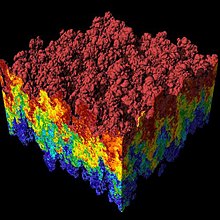모스/장거리 전위
Morse/Long-range potential| 계산물리학 |
|---|
 |
| 역학 · 전자기학 · 열역학 · 시뮬레이션 |
Morse/장거리 전위(MLR 전위)는 이원자 분자의 잠재적 에너지에 대한 원자 간 상호작용 모델이다.일반 모스 전위의 단순성(조정 가능한 매개변수 3개만 가지고 있다) 때문에 현대 분광학에서는 적용성이 매우 제한적이다.MLR 전위는 모스 전위의 현대판이며, 모스 전위의 이론적 장기적 형태는 자연적으로 내장되어 있다.[1]그것은 분광학자들이 실험 데이터를 나타내고, 측정을 검증하며, 예측을 하는 중요한 도구였다.잠재력의 특정 영역에 대한 데이터가 누락되었을 때의 외삽 능력, 가장 정교한 아비니티오 기법보다 종종 정확도로 에너지를 예측하는 능력, 분리에너지, 평형결합 길이와 같은 물리적 매개변수에 대한 정확한 경험적 값을 결정하는 능력에 유용하다., 및 장기 상수.특히 주목할 만한 사례는 다음과 같다.
- c-상태 Li2: 실험 데이터의 5000 cm 이상의−1 간격을 성공적으로 메울 수 있었던 MLR 전위.[2]2년 후, MLR 전위는 약 1 cm−1 이내에서 정확하게 이 간격의 중간에서 에너지를 성공적으로 예측할 수 있었다는 것이 밝혀졌다.[3]이러한 예측의 정확성은 당시 가장 정교한 ab initio 기법보다 훨씬 뛰어났다.[4]
- 리의2 A-상태: 르 로이 외 [1]연구진이 이전에 측정한 원자 발진기 강도보다 높은 정밀도에 대한 원자 리튬의 C3 값을 크기 순서로 결정하는 MLR 전위를 구성했다.[5]이 리튬 발진기 강도는 원자 리튬의 복사 수명과 관련이 있으며 원자 시계 및 기본 상수 측정의 벤치마크로 사용된다.
- KLi의 한 상태: MLR은 전위성의 상단 근처에서 관측된 적은 양의 수준만 존재함에도 불구하고 성공적으로 분석적 전위성을 구축하기 위해 사용되었다.[6]
역사적 기원
MLR 잠재력은 필립 M에 의해 1929년에 처음 소개된 고전적인 모스 잠재력에 기초한다. Morse. MLR 전위성의 원시 버전은 N에2 대한 연구를 위해 2006년 로버트 J. 르 로이와 동료들에 의해 처음 소개되었다.[7]이 원시적인 형태는 Ca2,[8] KLi[6], MgH에 사용되었고,[9][10][11][1] 2009년에 더 현대적인 버전이 도입되었다. 2010년2 Cs 연구에서 MLR3 전위로 언급된 MLR 전위의 추가 확장이 소개되었고,[12] 이후 이 전위는 HF,[13][14] HCl,[13][14] HBr[13][14] 및 HI에 사용되었다.[13][14]null
함수
Morse/장거리 전위 에너지 함수는 형식이다.
서 large r r
- ( r) e -( )+ ( r) ) D e {\V(simeq {\
따라서 ( ) 은 원자 간 상호작용에 대해 예상되는 이론적으로 올바른 장거리 동작에 따라 정의된다.null
이 MLR 모델의 장거리 형태는 지수의 인수가 장거리 동작을 갖는 것으로 정의되기 때문에 보장된다.
- ,
여기서 는 평형 결합 길이입니다.null
이러한 장거리 동작을 달성할 수 있는 몇 가지 방법이 있는데, 가장 일반적인 방법은 r) 을(를) 가 되도록 하는 다항식으로 만드는 것이다.
- ,
- ()= n - n + {
여기서 n은 1보다 큰 정수로서, 이 값은 장거리 잠재력 ( r) 에 대해 선택한 모델에 의해 정의된다..
다음을 보는 것은 분명하다.
- → (r ) = (
적용들
그 MLR 잠재력 성공적으로,:Li2,[1][2][15][3][10]Cs2,[16][12]Sr2,[17]ArXe,[10][18]LiCa,[19]LiNa,[20]Br2,[21]Mg2,[22]HF,[13][14]HCl,[13][14]HBr,[13]는 경우에는 14N2,[7]Ca2,[8]KLi,[6]MgH,[9][10][11]여러 전자를 포함한 이원자 분자들 번호에 대한 모든 실험 분광 데이터(및/또는 비리알 데이터)요약하고 있다.]HI,[13][14]MgD,[9]Be2,[23]BeH,[24]과 NaH.[25]보다 정교한 버전은 다원자 분자를 위해 사용된다.null
또한 아비니티오 포인트를 MLR 전위에 맞추고, 완전히 분석적인 아비니티오 전위를 달성하며, 이론적으로 알려진 정확한 단거리 및 장거리 동작을 전위에 통합하는 MLR의 능력을 활용하는 것이 관례화되었다(대개 분자 아비니티오 포인트보다 후자의 정확도가 높다).lves는 분자 ab initio 계산에 기초하기 때문에 분자 ab initio 계산에 통합하기 어려운 spin-dived coupling과 같은 특징들은 장거리에서 더 쉽게 처리될 수 있기 때문이다.MLR은 KLi와[26] KBe의 ab initio 포인트를 나타내기 위해 사용되어 왔다.[27]null
참고 항목
참조
- ^ a b c d Le Roy, Robert J.; N. S. Dattani; J. A. Coxon; A. J. Ross; Patrick Crozet; C. Linton (2009). "Accurate analytic potentials for Li2(X) and Li2(A) from 2 to 90 Angstroms, and the radiative lifetime of Li(2p)". Journal of Chemical Physics. 131 (20): 204309. Bibcode:2009JChPh.131t4309L. doi:10.1063/1.3264688. PMID 19947682.
- ^ a b Dattani, N. S.; R. J. Le Roy (8 May 2011). "A DPF data analysis yields accurate analytic potentials for Li2(a) and Li2(c) that incorporate 3-state mixing near the c-state asymptote". Journal of Molecular Spectroscopy. 268 (1–2): 199–210. arXiv:1101.1361. Bibcode:2011JMoSp.268..199.. doi:10.1016/j.jms.2011.03.030.
- ^ a b Semczuk, M.; Li, X.; Gunton, W.; Haw, M.; Dattani, N. S.; Witz, J.; Mills, A. K.; Jones, D. J.; Madison, K. W. (2013). "High-resolution photoassociation spectroscopy of the 6Li2 13Σ+ state". Phys. Rev. A. Vol. 87. p. 052505. arXiv:1309.6662. Bibcode:2013PhRvA..87e2505S. doi:10.1103/PhysRevA.87.052505.
- ^ Halls, M. S.; H. B. Schlegal; M. J. DeWitt; G. F. W. Drake (18 May 2001). "Ab initio calculation of the a-state interaction potential and vibrational levels of 7Li2" (PDF). Chemical Physics Letters. 339 (5–6): 427–432. Bibcode:2001CPL...339..427H. doi:10.1016/s0009-2614(01)00403-1.
- ^ L-Y. Tang; Z-C. Yan; T-Y. Shi; J. Mitroy (30 November 2011). "Third-order perturbation theory for van der Waals interaction coefficients". Physical Review A. 84 (5): 052502. Bibcode:2011PhRvA..84e2502T. doi:10.1103/PhysRevA.84.052502.
- ^ a b c Salami, H.; A. J. Ross; P. Crozet; W. Jastrzebski; P. Kowalczyk; R. J. Le Roy (2007). "A full analytic potential energy curve for the a3Σ+ state of KLi from a limited vibrational data set". Journal of Chemical Physics. 126 (19): 194313. Bibcode:2007JChPh.126s4313S. doi:10.1063/1.2734973. PMID 17523810.
- ^ a b Le Roy, R. J.; Y. Huang; C. Jary (2006). "An accurate analytic potential function for ground-state N2 from a direct-potential-fit analysis of spectroscopic data". Journal of Chemical Physics. 125 (16): 164310. Bibcode:2006JChPh.125p4310L. doi:10.1063/1.2354502. PMID 17092076.
- ^ a b Le Roy, Robert J.; R. D. E. Henderson (2007). "A new potential function form incorporating extended long-range behaviour: application to ground-state Ca2". Molecular Physics. 105 (5–7): 663–677. Bibcode:2007MolPh.105..663L. doi:10.1080/00268970701241656.
- ^ a b c Henderson, R. D. E.; A. Shayesteh; J. Tao; C. Haugen; P. F. Bernath; R. J. Le Roy (4 October 2013). "Accurate Analytic Potential and Born–Oppenheimer Breakdown Functions for MgH and MgD from a Direct-Potential-Fit Data Analysis". The Journal of Physical Chemistry A. 117 (50): 13373–87. Bibcode:2013JPCA..11713373H. doi:10.1021/jp406680r. PMID 24093511.
- ^ a b c d Le Roy, R. J.; C. C. Haugen; J. Tao; H. Li (February 2011). "Long-range damping functions improve the short-range behaviour of 'MLR' potential energy functions" (PDF). Molecular Physics. 109 (3): 435–446. Bibcode:2011MolPh.109..435L. doi:10.1080/00268976.2010.527304.
- ^ a b Shayesteh, A.; R. D. E. Henderson; R. J. Le Roy; P. F. Bernath (2007). "Ground State Potential Energy Curve and Dissociation Energy of MgH". The Journal of Physical Chemistry A. 111 (49): 12495–12505. Bibcode:2007JPCA..11112495S. CiteSeerX 10.1.1.584.8808. doi:10.1021/jp075704a. PMID 18020428.
- ^ a b Coxon, J. A.; P. G. Hajigeorgiou (2010). "The ground X 1Σ+g electronic state of the cesium dimer: Application of a direct potential fitting procedure". Journal of Chemical Physics. 132 (9): 094105. Bibcode:2010JChPh.132i4105C. doi:10.1063/1.3319739. PMID 20210387.
- ^ a b c d e f g h Li, Gang; I. E. Gordon; P. G. Hajigeorgiou; J. A. Coxon; L. S. Rothman (2013). "Reference spectroscopic data for hydrogen halides, Part II: The line lists". Journal of Quantitative Spectroscopy & Radiative Transfer. 130: 284–295. Bibcode:2013JQSRT.130..284L. doi:10.1016/j.jqsrt.2013.07.019.
- ^ a b c d e f g h Coxon, John A.; Hajigeorgiou, Photos G. (2015). "Improved direct potential fit analyses for the ground electronic states of the hydrogen halides: HF/DF/TF, HCl/DCl/TCl, HBr/DBr/TBr and HI/DI/TI". Journal of Quantitative Spectroscopy and Radiative Transfer. 151: 133–154. Bibcode:2015JQSRT.151..133C. doi:10.1016/j.jqsrt.2014.08.028.
- ^ Gunton, Will; Semczuk, Mariusz; Dattani, Nikesh S.; Madison, Kirk W. (2013). "High resolution photoassociation spectroscopy of the 6Li2 A(11Σu+) state". Physical Review A. 88 (6): 062510. arXiv:1309.5870. Bibcode:2013PhRvA..88f2510G. doi:10.1103/PhysRevA.88.062510.
- ^ Xie, F.; L. Li; D. Li; V. B. Sovkov; K. V. Minaev; V. S. Ivanov; A. M. Lyyra; S. Magnier (2011). "Joint analysis of the Cs2 a-state and 1g(33Π11g) states". Journal of Chemical Physics. 135 (2): 02403. Bibcode:2011JChPh.135b4303X. doi:10.1063/1.3606397. PMID 21766938.
- ^ Stein, A.; H. Knockel; E. Tiemann (April 2010). "The 1S+1S asymptote of Sr2 studied by Fourier-transform spectroscopy". The European Physical Journal D. 57 (2): 171–177. arXiv:1001.2741. Bibcode:2010EPJD...57..171S. doi:10.1140/epjd/e2010-00058-y.
- ^ Piticco, Lorena; F. Merkt; A. A. Cholewinski; F. R. W. McCourt; R. J. Le Roy (December 2010). "Rovibrational structure and potential energy function of the ground electronic state of ArXe". Journal of Molecular Spectroscopy. 264 (2): 83–93. Bibcode:2010JMoSp.264...83P. doi:10.1016/j.jms.2010.08.007.
- ^ Ivanova, Milena; A. Stein; A. Pashov; A. V. Stolyarov; H. Knockel; E. Tiemann (2011). "The X2Σ+ state of LiCa studied by Fourier-transform spectroscopy". Journal of Chemical Physics. 135 (17): 174303. Bibcode:2011JChPh.135q4303I. doi:10.1063/1.3652755. PMID 22070298.
- ^ Steinke, M.; H. Knockel; E. Tiemann (27 April 2012). "X-state of LiNa studied by Fourier-transform spectroscopy". Physical Review A. 85 (4): 042720. Bibcode:2012PhRvA..85d2720S. doi:10.1103/PhysRevA.85.042720.
- ^ Yukiya, T.; N. Nishimiya; Y. Samejima; K. Yamaguchi; M. Suzuki; C. D. Boonec; I. Ozier; R. J. Le Roy (January 2013). "Direct-potential-fit analysis for the system of Br2". Journal of Molecular Spectroscopy. 283: 32–43. Bibcode:2013JMoSp.283...32Y. doi:10.1016/j.jms.2012.12.006.
- ^ Knockel, H.; S. Ruhmann; E. Tiemann (2013). "The X-state of Mg2 studied by Fourier-transform spectroscopy". Journal of Chemical Physics. 138 (9): 094303. Bibcode:2013JChPh.138i4303K. doi:10.1063/1.4792725. PMID 23485290.
- ^ Meshkov, Vladimir V.; Stolyarov, Andrey V.; Heaven, Michael C.; Haugen, Carl; Leroy, Robert J. (2014). "Direct-potential-fit analyses yield improved empirical potentials for the ground X1Σg+ state of Be2". The Journal of Chemical Physics. 140 (6): 064315. Bibcode:2014JChPh.140f4315M. doi:10.1063/1.4864355. PMID 24527923.
- ^ Dattani, Nikesh S. (2015). "Beryllium monohydride (BeH): Where we are now, after 86 years of spectroscopy". Journal of Molecular Spectroscopy. 311: 76–83. arXiv:1408.3301. Bibcode:2015JMoSp.311...76D. doi:10.1016/j.jms.2014.09.005.
- ^ Walji, Sadru-Dean; Sentjens, Katherine M.; Le Roy, Robert J. (2015). "Dissociation energies and potential energy functions for the ground X 1Σ+ and "avoided-crossing" A 1Σ+ states of NaH". The Journal of Chemical Physics. 142 (4): 044305. Bibcode:2015JChPh.142d4305W. doi:10.1063/1.4906086. PMID 25637985.
- ^ Xiao, Ke-La; Yang, Chuan-Lu; Wang, Mei-Shan; Ma, Xiao-Guang; Liu, Wen-Wang (2013). "The effect of inner-shell electrons on the ground and low-lying excited states of KLi: Ab initio study with all-electron basis sets". Journal of Quantitative Spectroscopy and Radiative Transfer. 129: 8–14. Bibcode:2013JQSRT.129....8X. doi:10.1016/j.jqsrt.2013.05.025.
- ^ Xiao, Ke-La; Yang, Chuan-Lu; Wang, Mei-Shan; Ma, Xiao-Guang; Liu, Wen-Wang (2013). "An ab initio study of the ground and low-lying excited states of KBe with the effect of inner-shell electrons". The Journal of Chemical Physics. 139 (7): 074305. Bibcode:2013JChPh.139g4305X. doi:10.1063/1.4818452. PMID 23968090.














